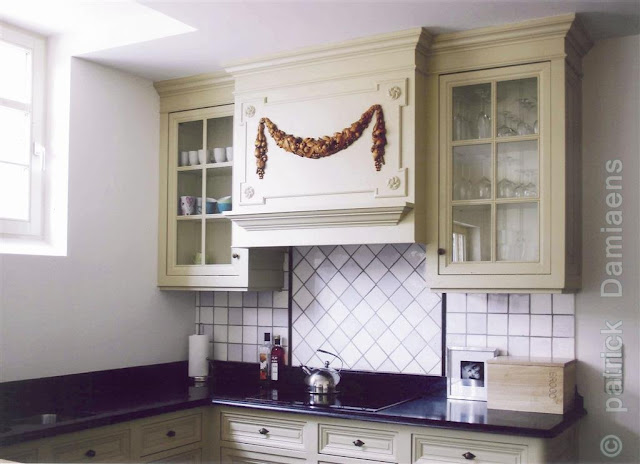 |
| A Baroque Style Fruit and Floral Garland |
Patrick Damiaens
Ornamental Woodcarver
A Festoon or garland
Fruit, tied together in combination with leaves and flowers was
a popular decoration in the Roman
period, and also later in the ornamental
decoration of the Renaissance and later style
periods.
This form of ornamentation, decorative
ornaments we can distinguish
two different applications
1. A drooping form, In English this
is called Clusters, "A
coherent bundle of
fruit and leaves' vertically suspended from a ribbon, and this (if necessary)
repeating at the same ribbon. This 'Festoon' was
widespread if more length than width were present
to decorate. (Pilasters and pillars)
2. The festoon in pending form
(most known) hangs
from the two ends, is slightly curved and
the present fruit
and leaves are held together by a
ribbon or rope. The correct name is Festoon
or garland.
The 2 ends or attachment points
are usually in the form of a rosette, button, ribbon or nails. Less commonly, in
the form of faces or even skulls.
A festoon in the form of
oak leaves, laurel leaves or even seafood tied together is another way
which is very common in the ornamentation and decoration.
Origin
The origin of the festoon
or the application is actually very
simple, in the Roman temples were these festoons
of real fruit and flowers hung on the friezes
and columns of sacred
places. These festoons of fruit and flowers were
possible, specific conditions combined with sacrificial animals, skulls or religious artefacts.
This style of decorating was many
centuries later (Renaissance) not
only in sacred, but
also in other (worldly) architectural buildings.
In the Roman period, the empty space above the festoon was filled
up with rosettes, masks or figures.
 |
| Patrick Damiaens, Carving a Festoon |
In the Italian
Renaissance, these items were replaced on the tombs and ecclesiastical
architecture by Putti.
The Renaissance
transformed the appearance of the Festoon in a more or less modified
form, but it was no longer possible to ignore these types of ornaments in architecture, decoration and furniture art.
Later style periods will each have
their own specific characteristics and influence on this
type of ornament.
In the
present time of ornamental
decoration, it is still possible
to apply this ornament in a tasteful
way , the following pictures show some possibilities, which
were carried out by our Workshop.
 |
| Garland carved in limewood |
 |
| garland in combination with instruments |
 |
| Festoon carved in wood for a kitchen |
More information about my work as a woodcarver
 |
| https://www.patrickdamiaens.info |





Beautiful work!! Amazing!
ReplyDelete